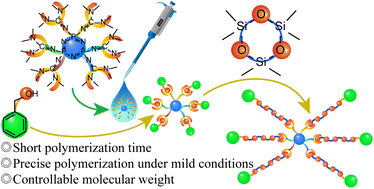Synthesis of guanidinophosphazene superbase for the facile preparation of high molecular weight polysiloxane under mild conditions†
Abstract
In one step, two bulk chemicals of hexachlorotriphosphonitrile and 1,1,3,3-tetramethylguanidine were selected to prepare a guanidinophosphazene superbase 2,2,4,4,6,6-hexa(tetramethyl-guanidyl)-1,3,5,2λ5,4λ5,6λ5-cyclictri(phosphazene) (HTGCP, pKa of 27.2 in MeCN). The obtained HTGCP exhibits extremely high catalytic performance toward hexamethylcyclotrisiloxane (D3) in toluene and the conversion can exceed 99% under mild conditions within 10–60 min (molecular weight Mn = 10–836 kg mol−1). At high monomer dosage, Mn can be increased to 1136 kg mol−1 at 120 min. The structure and Mn of the resulting polymer have been confirmed by GPC, 1H NMR, 29Si NMR, and matrix-assisted laser desorption/ionization time-of-flight mass spectroscopy (MALDI-TOF MS). The ionic reaction between initiator and HTGCP ensures polymerization in the form of first-order reaction kinetics. Meanwhile, the polymerization rate constant increases remarkably with the increase in HTGCP concentration and the excellent linear relationship between Mn and [M]/[I] indicates well-controllable polymerization for D3. In addition, the HTGCP can still obtain high Mn for the polymerization of octamethylcyclotetrasiloxane (D4) and tetramethyl tetravinyl cyclopentasiloxane (V4), while the molecular weight distribution is relatively broad. As a superbase, HTGCP has a simpler preparation method and exhibits good application in organic polymerization under mild conditions.



 Please wait while we load your content...
Please wait while we load your content...